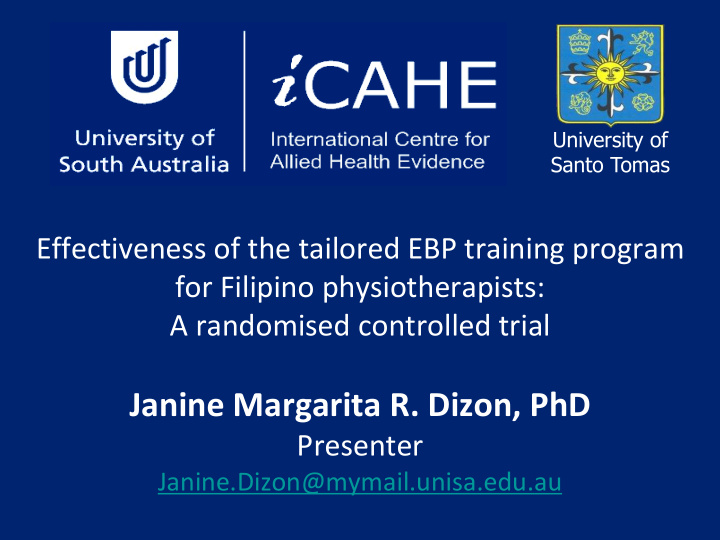



University of Santo Tomas Effectiveness of the tailored EBP training program for Filipino physiotherapists: A randomised controlled trial Janine Margarita R. Dizon, PhD Presenter Janine.Dizon@mymail.unisa.edu.au
UST Background • EBP is an integral component of the health system • EBP is essential in developing countries particularly due to the limited resources • Basic training needs to be provided which should filter through improved knowledge and skills and through implementation and utilisation in practice • In the Philippines, there is no widespread training in EBP • IMPORTANT: training in EBP needs to be delivered considering the local context issues – Physiotherapists in the Philippines are not first contact practitioners – Treatment is largely based on a treatment prescription • Designed a research project to develop, implement and evaluate a tailored EBP training program (Methods figure.pdf)
UST Aims (Dizon et al 2011, BMC Medical Education study protocol) 1. To assess the effectiveness of the EBP training program in improving knowledge, skills, attitudes and behaviour of Filipino physiotherapists; and 2. To provide a tested model of a continuing education training which is contextually designed to Filipino physiotherapists and could be adapted readily for physiotherapists from other developing countries, and allied health professionals who are not first contact practitioners in any health care system.
UST Methods • Ethics – Ethical approval granted by the University of South Australia’s Human Research Ethics Committee • Design – RCT with a waitlist control group was designed to answer the study objectives • Sample – Physiotherapists in the Philippines from • a database of physiotherapists obtained from a preliminary descriptive survey study (Dizon, Grimmer-Somers and Kumar 2012), the network of the professional association and a list of hospitals in the yellow pages (telephone) – Potential participants were screened for the following criteria: • Licensed physiotherapists and have not undergone any previous formal EBP training – Sample size for this study was calculated from the findings of the pilot RCT (Dizon, Grimmer-Somers and Kumar 2012) using Medcalc software.
UST Methods • Intervention – Components based on the model of complex interventions • Core/Fixed component – Steps to EBP (Sicily Statement of EBP 2005) • Variable component – EBP checklist for recommending evidence based (EBP Checklist.doc) – Online support – Printed materials – Teaching in the context of local learning – More practical sessions
UST Methods • Outcome measures (EBP domains) – Knowledge and skills • Adapted Fresno Test (McCluskey and Bishop 2010) – Attitudes • Attitudes Scale (Stevenson et al 2004) – Behaviour • Behaviour diaries (Behaviour diary.docx) • Consort diagram ( Consort diagram.docx)
UST Results AFT scores EBP group (N=27) Control group (N=27) P value Effect size (total= (Mean, SD, 95% CI) (Mean, SD, 95% CI) 0-156) Pre training 19.7 (18.6) 12.7 – 26.7 20.4(18.5) 13.4 – 27.4 0.88 Post training 64.3 (18.0) 57.5 – 71.1 23.2 (19.3) 17.1 – 31.7 <0.05* 0.74 3 months 56.7 (21.5) 48.6 – 64.8 19.1 (20.6) 11.3 – 26.9 <0.05* 0.67 post training
UST Results Changes in EBP knowledge and skills of physiotherapists 156,0 136,0 116,0 96,0 U95%CI 76,0 L95%CI mean 56,0 36,0 16,0 -4,0 EBP control EBP control EBP control Pre training Post training 3months post training
UST Results Changes in EBP attitudes • At immediate post-training and three months post-training, statistically significant differences were found between the groups in terms of attitudes , specifically in terms of the following EBP activities: – lacking confidence in undertaking a literature search (more physical therapists disagreed to this in the EBP group than the control group) and – confidence in undertaking a critical appraisal (more physical therapists agreed to this in the EBP group than the control group).
UST Results Comparison of activities between EBP and control groups when faced with unique case s 100,0 95,9 89,8 85,7 Unique cases 77,5 80,0 65,0 60,0 47,5 EBP group 40,0 Control group 32,5 22,5 20,0 15,0 15,0 12,5 6,1 0,0 formulated logged PICO searched article appraised applied asked colleague asked MD read textbook PICO evidence evidence EBP behaviours (percent) non-EBP behaviours (percent) The EBP group was 80 times more likely to make EBP-based choices, than the control group (OR 80.0 (95%CI 22.7-336.4)).
UST Results Comparison of activities between EBP and control groups when faced with usual cases 100,0 85,2 Usual cases 81,5 80,0 70,4 68,3 63,0 56,1 60,0 44,4 EBP group 37,0 40,0 Control group 26,8 22,2 18,5 20,0 7,3 0,0 formulated logged PICO searched article appraised applied asked colleague asked MD read textbook PICO evidence evidence EBP behaviours (percent) non-EBP behaviours (percent) The EBP group was 37 times more likely to make EBP-based choices than the control group for usual cases (OR 36.8 (95%CI 10.2-157.1)).
UST Bottom line • This training program took the form of a complex intervention, by providing context-specific EBP training for Filipino physiotherapists. It was shown to be an effective and acceptable model of continuing education in improving all EBP domains of knowledge, skills, attitudes and behaviour in the short term • More work needs to be done to fully integrate a culture of EBP in the Philippines
UST Thank you
Recommend
More recommend